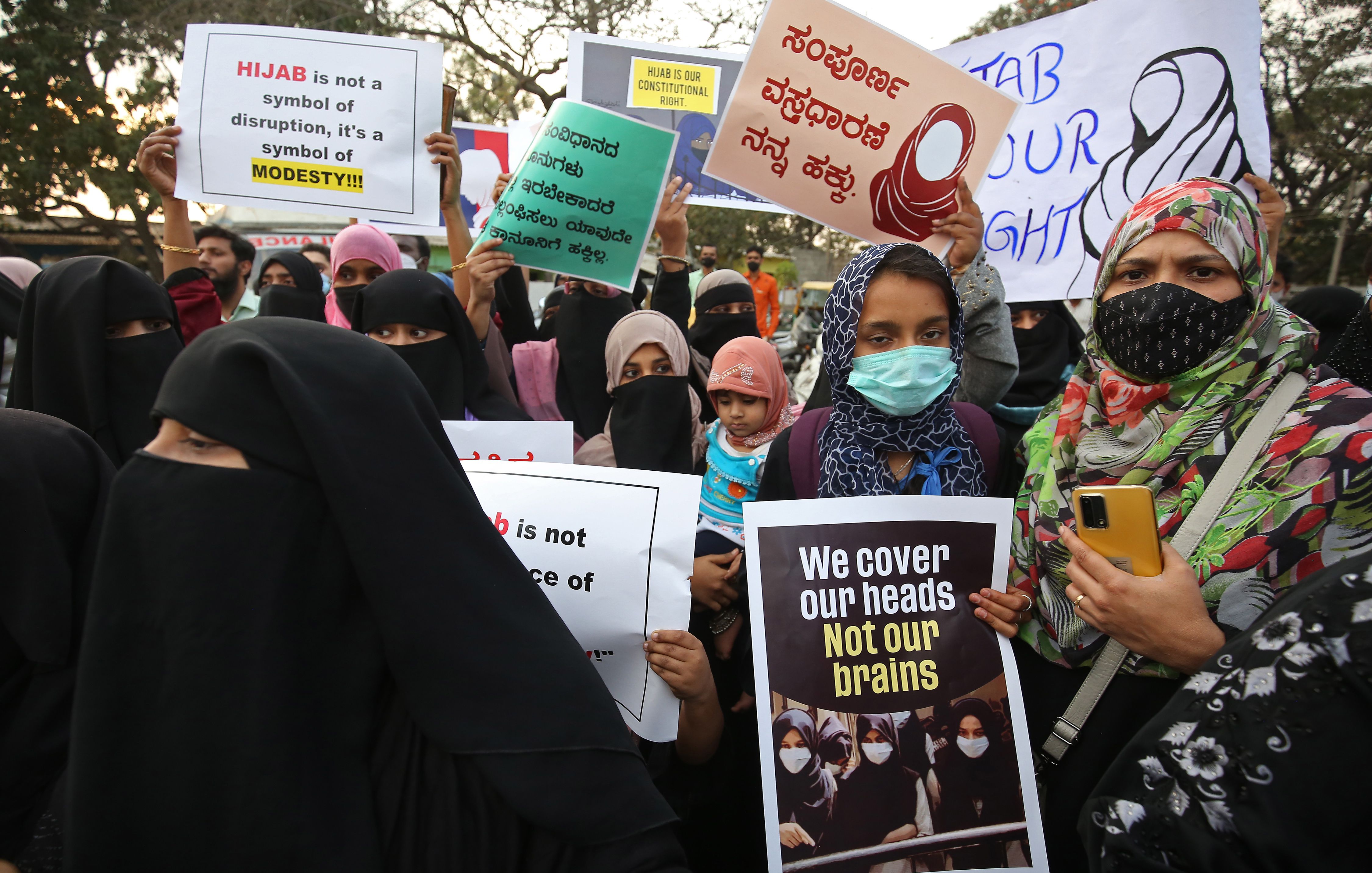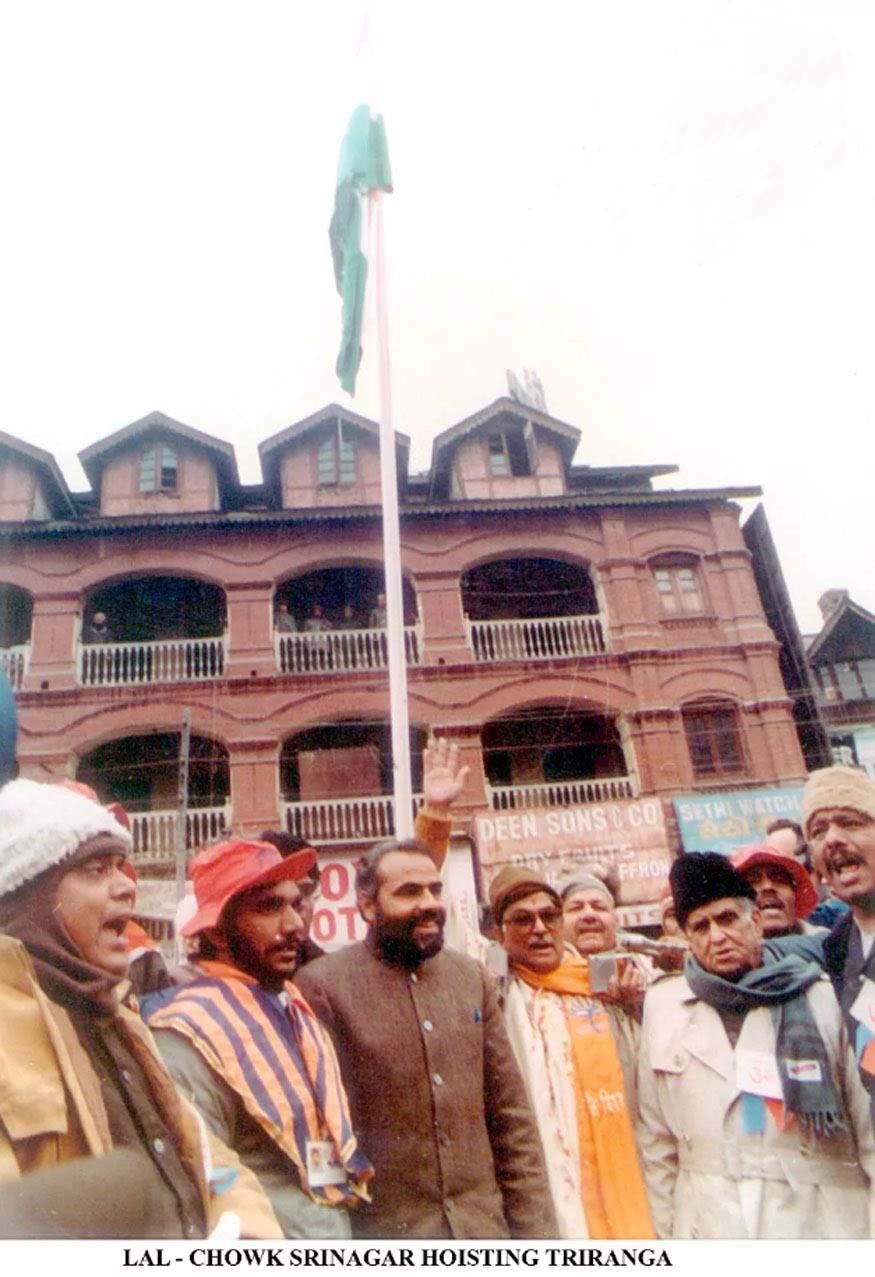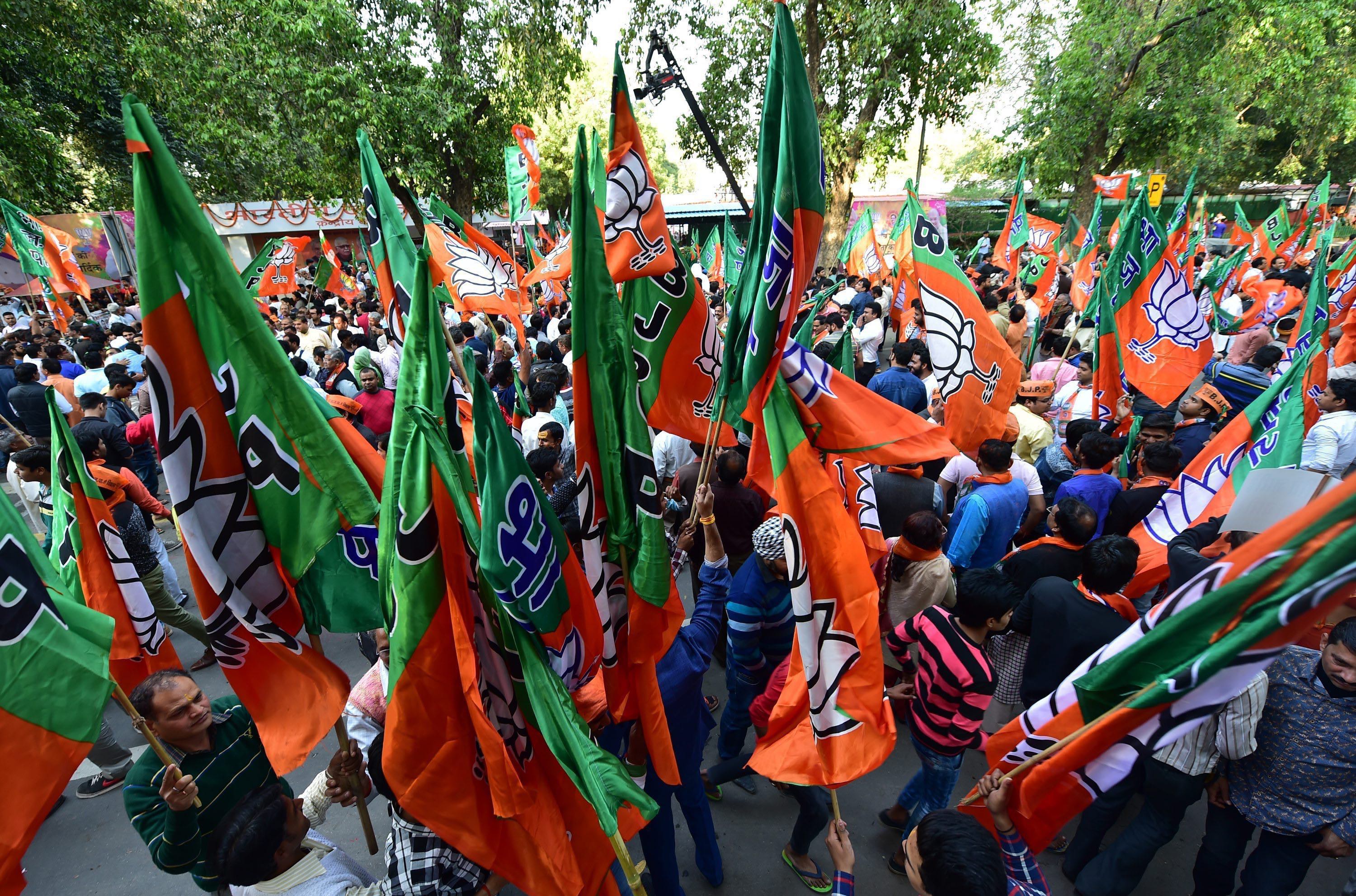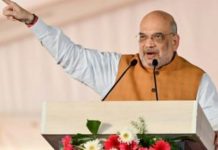
One cannot take away from Prime Minister Narendra Modi’s grit and determination to usher in a naya Bharat. Neither should we overlook his Party’s attempts to tell the minorities, particularly the Muslims, that this is not a country that they can call their own.
This year the officials in the Finance Ministry were deprived of eating “halwa”. Equally, citizens were bereft of Abide by Me .. at Beating Retreat ceremony, reportedly Mahatma Gandhi’s favourite hymn.
On the other hand, saffron invaded the length and breadth of the country: literally from Kashmir to Karnataka.
If BJP went to town over the national flag being unfurled in Srinagar’s controversial Lal Chowk, Hindu boys sported saffron scarves to counter Muslim girls wearing hijab in colleges in Karnataka.
This is the sum total of a new India: one which BJP has handcrafted to showcase to its billion plus people. Critics see it as BJP’s way of thrusting nationalism on people, who for decades have defined it in an idiom of their own.
This is a new India with a difference. It is not one that evolves naturally but one that is beaten to change. Therefore, BJP’s India has three components: break tradition; erase all signs of colonialism; and usher saffron in the garb of nationalism.
Not all of this is bad; but it is not acceptable in toto either. There is a different dimension to each and consequently a specific fall-out. If Modi bashers slam the negatives, his loyalists flag their version of the positives.
One cannot take away from Prime Minister Narendra Modi’s grit and determination to usher in a naya Bharat. Neither should we overlook his Party’s attempts to tell the minorities, particularly the Muslims, that this is not a country that they can call their own.

Clearly, this invades the idea of a secular India but then BJP has always lashed out at the concept of secularism and rubbished it on grounds of minority appeasement. Worse still, it is not apologetic of pushing its concept of a Hindu rashtra which it imagines is intrinsic to the idea of India, rather Bharat. And for that even if it needs to unleash communalism and throttle democracy, so be it.
A case in point is the recent saffron scarves versus hijab controversy that unfolded in the BJP ruled state of Karnataka.
The seeds were sown in December last year but the issue took a serious turn as the new year set in. It began when Muslim girls in Udupi were debarred from attending classes for wearing a hijab, a head scarf.
For the uninitiated, a hijab is worn by Muslim women for privacy and modesty. It is a tradition deep-rooted in Islam. The jury is out on whether the tradition is coercive or voluntary.
The issue spread to other colleges in the state when authorities banned hijab on grounds that it violated the prescribed dress code for students.
Things became volatile with Muslim girls protesting that wearing a hijab is a fundamental right. To up the ante, Hindu students came out sporting saffron scarves. And if that was not enough, Dalit students from a college in Chikmagalur adorned blue scarves. If saffron was the colour of hostility to the hijab, apparently, blue was one of solidarity.
Colour apart, the issue has raised a stink. Apart from vertically dividing the student community, it has exposed the BJP and its anti-Muslim stance. Worse still, it has made it known to the Muslims that their religious entitlements are under question under the garb of nationalism.
It is against this backdrop that it is important to assess what BJP state unit chief said underlining the arrogance of having a BJP government in the state: “There is a BJP government in the state and there is no scope for hijab, ” he had said clearly signalling that the new order which is in place has no room to accommodate an alternative viewpoint.
The BJP has alleged a “hidden hand” behind the ruckus. Even if it is right, nothing can justify the ban which is akin to imposing its will on a community’s religious tenets.
BJP’s fear that complying with the hijab-demand could lead to another for a mosque in the college, may not be entirely baseless but what it needs to ask itself is: if a situation warrants, will Sikh boys be barred from wearing turbans?
Often accused of creating a false narrative, the BJP is also in the eye of a storm over the national flag unfurling in Srinagar’s controversial Lal Chowk area.
On Republic Day, the saffron Party went to town over the tricolour being hoisted atop the Clock Tower in Lal Chowk in the heart of Srinagar.
Activists, allegedly propped up by the BJP, called it a “magical moment”, while others dubbed it as historic.
Unfurling or hoisting a national flag is decidedly a goosebump-moment for any nationalist. Hence on this count, there are no surprises.
The state of Jammu and Kashmir does throw up challenges coupled with a little bit of intrigue. Therefore, any move particularly one that has an overdose of nationalism is bound to grab eyeballs.
The unfurling of the national flag at Lal Chowk was one such. It was peddled by the BJP as an event that was made possible after 30 years. Of course there are versions saying that it was the first since Independence. Timeline apart, BJP publicists decided to milk the event to their advantage. That a part of it backfired, is another matter.
As India celebrated its 73rd Republic Day, a hydraulic crane carrying activists and the national flag atop the clock tower were widely publicized.
The significance of the tricolour at the site can be deciphered from the fact that several attempts in the past to hoist the flag were foiled by anti-national elements. The last time the Indian flag fluttered there was way back in 1992 when BJP’s Murli Manohar Joshi unfurled it at the height of militancy in Jammu and Kashmir.
“Since Independence, we have only seen Pakistani flags hoisted here …today hoisting the national flag on top of the Clock Tower is what Naya Kashmir stands for”, said one among the flag-bearers.
Sceptics however rubbish the claim about the BJP branding this as a “first”. Dubbing it as a false narrative, they say that there is nothing sacrosanct about Lal Chowk, hence the hullabaloo is only optics.
Politics played out with the Opposition questioning the BJP’s move of bringing down the flag within hours of its unfurling on grounds that it violated the Flag Code wherein “the flag should be flown from sunrise to sunset”. Others slammed it as a photo-opportunity.
Exaggerated as the move may be, one cannot undermine the spirit that was amplified even as participants danced to patriotic songs and hundreds of Indian flags fluttered across the valley.
In this context, one cannot take away from the BJP’s effort to bring Kashmir centre-stage; drive home a narrative that the state is firmly in India’s grip; and at the same time tell Pakistan that the territory is non-negotiable. While there may be loopholes in its theory of Naya Kashmir, the messaging is foolproof.
If the national flag initiative in Kashmir is laudatory, then on Netaji Subhas Chandra Bose, the government is on weak wicket.
While the initiative cannot be questioned, the placement of Netaji’s statue under the canopy of India Gate has been slammed.
The canopy that was built as a tribute to the Emperor of India, King George V, showcased him in his coronation robes and the Imperial State Crown. The statue was, however, removed in the late sixties in a bid to erase the footprints of imperialism in independent India.
On January 23, this year Narendra Modi unveiled a hologram of Bose there: a stop-gap arrangement till the one in granite is installed.
The move to install Bose’s statue was long overdue given that many national heroes were ignored, thanks to the Congress’ hegemony. Modi decided to correct this wrong and honour leaders other than the Nehru-Gandhi family who have hijacked India’s freedom struggle to their advantage.
Yet the idea of Bose’s statue under the canopy drew flak, it being a grim reminder of the British rule and India’s slavery. Therefore, to see him under a canopy built in honour of those he fought to drive out, is inappropriate, to say the least. So, the question that stares hard in the face is: Will Bose turn in his grave?

Even while BJP scouts for answers, fingers are being pointed at it on another count: dropping Abide With Me from Beating Retreat and replacing it with Aye Mere Watan ke logo.
Written by Henry Francis Lyte, the hymn was seen as a highpoint of the Retreat. The last piece to be played before buglers bring down the flag, it has been an integral part of the Retreat since 1950.
What perhaps went against the ethos of the BJP was the foreign origin of the hymn: the concept of music being universal, seemingly alien to those painting the country saffron.
But it is the other argument that cuts ice: to include tunes that have a wider connect, particularly one that commemorates Indian soldiers who died in the Indo-China war in 1962. On this, the BJP government cannot be faulted.
Therefore, the hue and cry about dropping Mahatma’s favourite hymn is misplaced. For non-Gandhians, this is no big deal. A Mahatma’s favourite cannot dictate an entire nation; nor can it be the basis of compromising popular appeal.
Using a tune that resonates with the masses makes more sense and Mere Watan…fits the bill. Those shedding tears over Abide… have failed to erase colonialism and embrace nationalism in its essence. Tradition should not be the excuse to retain stuff that should have been shunned years ago.
As for tradition, Union Finance Minister Nirmala Sitharaman did well by abandoning the briefcase and the halwa ceremony: both hand-downs from past regimes. Till Sitharaman changed it, the briefcase and the halwa were prerequisites of the Union Budget.
It was in 2019 that Sitharaman abandoned the briefcase and substituted it with a bahi-katha, a ledger; last year it was a tablet reportedly to adapt to changing times. This year the halwa ceremony was done away with.
For the uninitiated, the halwa ceremony precedes printing of budget documents. Officials involved in the process are fed halwa with the Union Finance Minister initially acting as server. Amid fears of Omicron, the halwa ceremony was dispensed with, this year. The government also went paperless and did away with printing the Budget.
It would be a folly to rubbish every move of the Modi government; as it would be to sing paeans. At best, it could be dubbed a mixed bag with its share of good and bad; perception and ground feel; optics and reality, and accept that BJP’s saffron dipped Bharat is the new order uprooting the old.













